Schedule Sabotage
This blog post is a fun one for me. What I am about to talk about goes against the grain of EVERY special education teacher’s instinct. Yes, you read it right. We are going to talk about sabotaging our daily schedules that are so crucial to our students success. To read about visual schedules in my classroom click HERE to learn about some of the best practices of special education schedules!
One of the toughest things our kiddos experience in a special education classroom is confusion. My students struggle the most when our schedules get mixed up, out of order or something happens out of our control that requires flexibility. As special education teachers, we cannot always predict certain aspects of our day. Sometimes a tantrum may require a smooth transition outside for a walk, a surprise fire drill, a visitor walk through or a cancelled special. This can cause such epic tantrums in my classroom that I have started a new thing called “schedule sabotage.” This is when I mess something up on purpose. Teaching flexibility is an important skill because our students will not have a perfectly planned out life- they must learn to go with the flow. This is not an easy task. But whenever I do mess something up I let my staff now ahead of time so we are ready to cope with any side affects we may get.
There are really no “rules” to sabotaging a schedule. Sometimes I will mess up my class schedule in the front of the classroom, sometimes I will target the whole class’ individual schedules and sometimes I will mess up just one students schedule. I don’t do this often- no more than once a month. Here are a few examples of sabotage you can try in your classroom:
1. Forget all of the schedule icons.
Simply forget to do schedules using this “forgetful sabotage.” Have the students check a blank schedule ton see how they will respond. Are they able to set it up themselves? Will they ask for help? Do they know what is expected of them?
2. Mess up half of the daily schedule
Sometimes I will try to disguise the sabotage by only messing up half of the schedule. The beginning of the day can fun smoothly and then after lunch you can switch a few things around.
3. Scatter the icons across the schedule and leave some blank spaces
Simply go crazy. Spread them around, leave some blank spots, spread them out, put them in a random order. I call this the “throw up sabotage!” Just make it as bizarre as possible!
4. Forget a preferred schedule icon.
At a quick glance the student will think their schedule is correct. When the child goes to check their schedule they may notice that they are missing a preferred item. In this example I skipped over recess. Sometimes recess gets cancelled due to rain- emergencies, lock down etc. Practice taking away recess without any priming. Sometimes I will say something like, “Whoops, I forgot about recess!” On other days I will simply skip recess and have kids stay inside etc. This is a great way to teach flexibility- but it is also the most challenging.
5. Throw a preferred item in on accident.
This is a “teaser sabotage” which is also a very challenging skill to teach. In this example below I added “party” instead of work centers. When my student notices the party on their schedule I will simply say, “Whoops- no party today. Time for work.” This is a good way to teach kids that sometimes good things can be taken from you. While I know this is mean, and not recommended to be done often- it’s good to help children cope with the feeling of disappointment.
Schedule Sabotage is a good way to help students learn to manage emotions that come with the unknown and uncertain aspects of life. I tend to sabotage schedules no more than one time a month. There is a fine line you can cross if you do this too often, as we don’t want students to not trust their daily schedule. Daily schedules are the backbone to a special education program. Without them- you could not survive! Using this little trick of sabotage can help students for the days when something goes unplanned- for example a kiddo pulls a fire alarm and an unplanned evacuation needs to occur!
Check out my day schedule binder version to implement in our classroom:
 |
| Add caption |













